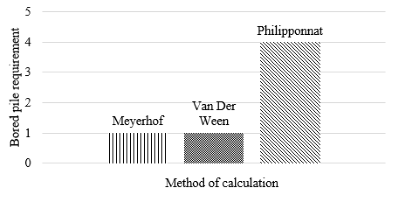Comparative Analysis of Bearing Capacity of Pile Foundation Using Van Der Ween, Philipponnat, and Meyerhof Methods
DOI:
https://doi.org/10.24036/cived.v10i3.3Keywords:
Bearing capacity, Meyerhof, Van der Ween, Philipponnat, Maximum loadAbstract
Soil has different characteristics so that it becomes a lot of problems in Civil Engineering construction, especially in foundation planning, it must be done carefully and use several methods as a comparison. This research is to compare the three methods of calculating the bearing capacity of bored pile foundations: Van Der Ween, Phillipponnat, and Meyerhof. The selection of an apposite method in bearing capacity analysis is important to confirm the safety of the building structure. The Van Der Ween Method is a more modern and detailed approach compared to the Meyerhof Method, it takes into account the negative impact of the lateral deformation of the pile, which improves the accuracy of its calculation. The Philipponnat Method is a method that combines aspects of both the Meyerhof Method and the Van der Ween Method, it considers load characteristics and soil properties like Meyerhof, while also accounting for lateral deflection of the piles like Van der Ween. The results show that each method has advantages and disadvantages in determining the bearing capacity of bored pile foundations. Analysis revealed factors such as pile diameter, soil depth, and maximum applied load affect the accuracy of the three methods. This research provides important insights for construction planners in selecting a suitable method for bored pile foundation bearing capacity analysis. It is recommended that soil characteristics and pile geometry be considered before selecting the most appropriate calculation method. This research can be extended by considering other methods and conducting validation through experimental analysis.
Downloads

Downloads
Published
How to Cite
Issue
Section
License
Copyright (c) 2023 Muhammad Fitrah Hidayatullah, Andi Marini Indriani, Gunaedy Utomo

This work is licensed under a Creative Commons Attribution 4.0 International License.







2.jpg)
